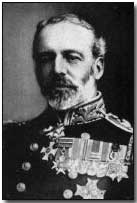Who's Who - Sir Christopher Cradock
 Sir Christopher George Francis Maurice
Cradock (1862-1914) fought and lost an unequal battle with German Admiral
Graf von Spee on 1
November 1914 at
Coronel (near Chile), losing his own life in the process
and sowing seeds of doubt as to the ability of Britain's Royal Navy to rule
the seas during the initial months of the war.
Sir Christopher George Francis Maurice
Cradock (1862-1914) fought and lost an unequal battle with German Admiral
Graf von Spee on 1
November 1914 at
Coronel (near Chile), losing his own life in the process
and sowing seeds of doubt as to the ability of Britain's Royal Navy to rule
the seas during the initial months of the war.
Cradock was born on 2 July 1862 in Yorkshire, and entered the Royal Navy in 1875. In 1878 Cradock was present at the British occupation of Cyprus, serving as a midshipman.
Having served on the Royal Yacht Cradock was made commander of Alacrity, upon which he saw action with the storming of the Taku Forts on 17 July 1900, serving with distinction. He subsequently directed Allied forces during the relief of Tientsin and, later, Siku.
Cradock was promoted Rear-Admiral in 1910, by which time he had established himself as the author of numerous works. Created KVCO in 1912, Cradock was appointed to the command of the North American and West Indies station the following year, 1913.
With the declaration of war in August 1914 Cradock was given responsibility for protecting the North American coast from St. Lawrence to Brazil; and, from October with the pursuit of Spee's fleet of commerce raiders with his own somewhat old and inferior 4th Squadron.
Having located Spee's force, Cradock engaged them in battle but was hopelessly outfought, with Spee able to call upon Scharnhorst, Gneisenau, Leipzig, Dresden and Nurnberg. Within two hours his force was greatly reduced, including both main ships Good Hope (the flagship) and Monmouth, with some 1,600 men drowned.
The Russian war ace Alexander Kozakov claimed 20 victories during the war; his nearest compatriot, Vasili Yanchenko, claimed 16.
- Did you know?
